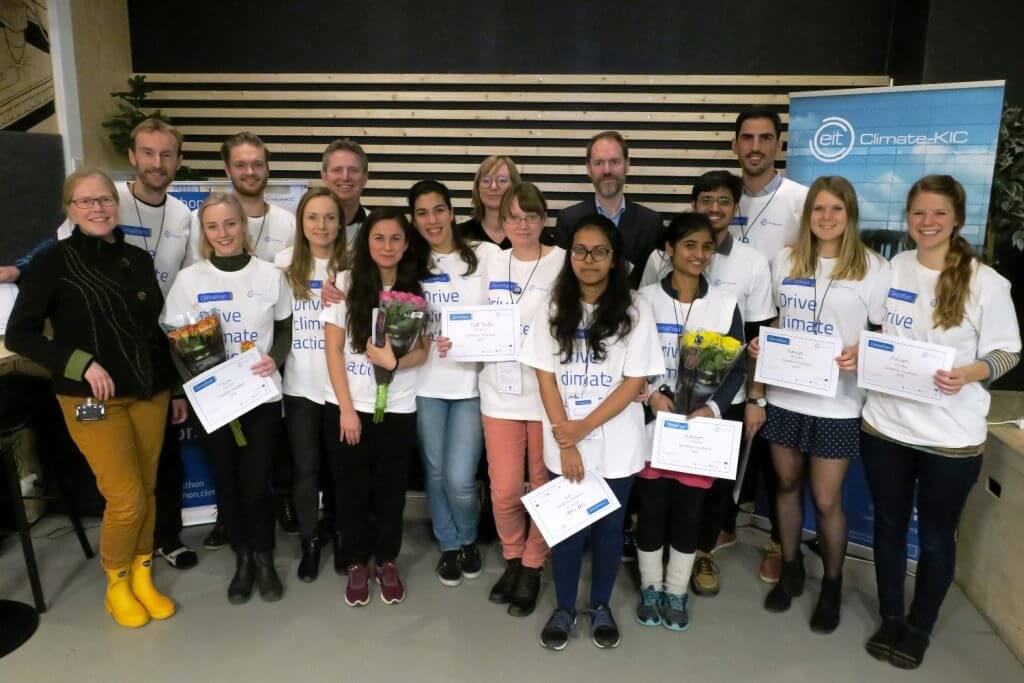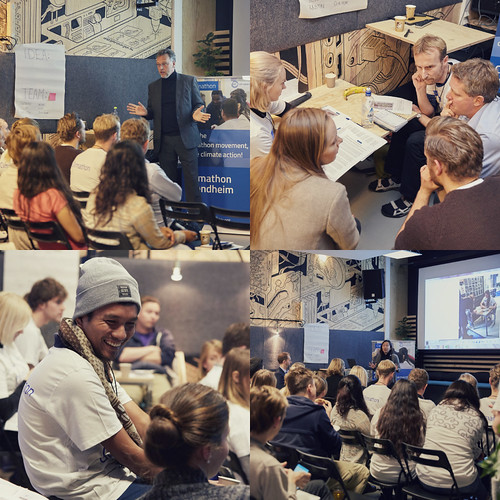Climathon Results in Seven Brilliant Ideas to Solve Climate Challenges

Participants in the Trondheim Climathon last weekend offered a number of novel solutions to how the city can reduce CO2 emissions from the transport sector. Winners received 20 000 NOK, coaching sessions and meetings with Trondheim Municipality creating the best conditions for their idea to be implemented.
At 11 AM Friday 28 November, the Trondheim Climathon gathered 40 participants of 13 different nationalities for 24 hours of co-creating solutions to Trondheim’s climate challenges. The event was organised by Trondheim Municipality, Technoport and Climate-KIC partner NTNU and took place at DIGS – Trondheim’s Innovation Platform.
We are ready! #Climathon #ClimathonTRD pic.twitter.com/bhTN8t8dtC
— Ida S. Åsle (@idasofiea) October 28, 2016
[xyz-ihs snippet=”Climathon-2017-CTA”]
Trondheim is in need of innovative solutions to reduce CO2 emissions from the transport sector
CO2-emissions from the transport sector account for approximately 50 % of the total CO2-emissions in Trondheim. Recent statistics show that car usage has increased by 2.6 % from 2014 to 2015. A need has been identified for measureable, integrated, and engaging solutions to reduce the CO2-emissions from the transport sector in the area called the “Knowledge Axis” and the City of Trondheim.
The Knowledge Axis (Kunnskapsaksen) is a heavily trafficked and populated area stretching from the south to the north of the city. Its name derives from encompassing many of the most prominent knowledge actors within research, education, industry and the public sector. This knowledge-intensive area will be the playground of Trondheim’s future growth. Exciting processes are in motion already, including the relocation of Norwegian University of Science and Technology (NTNU) campus , super buses running along the artery of public transportation and Elgeseter street Living Lab, just to name a few.
An encouraging municipality
Trondheim Municipality has been working towards sustainability for a long time already, partly through the implementation of the unique “Environment Package” (Miljøpakken): a holistic cooperative project between public actors for transportation which aims to minimise traffic jams and CO2 emissions while ensuring smooth and easy mobility for Trondheim’s citizens.
The municipality’s prioritisation of the environment and sustainability was manifested through its engagement in the Climathon. No less than three speakers devoted parts of their weekend to share the city’s goals within sustainability, and explain the present challenges to the problem solvers at the Trondheim Climathon. Deputy Mayor Hilde Opoku also stopped by to see the progress and feel the energy.
Deputy mayor of @Trondheim @hildeopoku came by to say hello! #climathon #climathontrd pic.twitter.com/znVSixVRx7
— Climate-KIC Nordic (@CKICNordic) October 28, 2016
Collaboration and coordination
Though largely unknown to each other, the participants quickly formed groups based on their interests in some of the initial ideas presented in a plenary session.
“It’s incredible how quickly and deeply you get to know each other by working together for 24 intense hours. It feels like we’ve been friends for years” – Participant at Trondheim Climathon.
The stretches of hard work were broken up by expertly timed exercise sessions. A sitting yoga session in the mid evening and partner yoga closer to midnight minimised the number of sore necks and tense muscles. In the morning, a peaceful session of tai-chi refreshed the participants prior to pitching their ideas and work to the jury.
Climathon Comes Up With Seven Brilliant Ideas to Solve Climate Challenges
Seven innovative solutions for a greener Trondheim
Saturday morning, the seven groups, some without having slept at all, pitched their ideas to a jury consisting of Marianne Langedal, Director of the Environmental Department, Trondheim Municipality, Annemie Wyckmans, Vice Dean of Research at the NTNU Faculty of Architecture, Haakon Skar, Founder and CEO of T:Lab, and Gøril Forbord, Business Developer, TrønderEnergi.
While all seven groups had impressive results, three solutions stood out. These were awarded 5 000, 10 000, and 20 000 NOK respectively, and the winning team will receive coaching from jury member Haakon Skar to refining their idea further.
Third place went to ADapt, consisting of Laura Brodbeck, Paritosh Deshpande, Priyanka Dhar, Pedro José og Sunniva Bratt Slette, all former or current NTNU students. Their idea was to develop a sustainable, comfortable and effective net of bus stops financed by advertisements. Green roofs and adjacent bike parking would contribute to improved air quality and a sustainabily of each passenger’s entire travel route.
https://twitter.com/idasofiea/status/792280122019708929?ref_src=twsrc%5Etfw
The runner up was T-Hub, with their idea of a holistic and customisable public transport scheme including electric super buses, autonomous cars, and automated grocery shopping solutions. This team consisted of the NTNU students Cathrine Ro Heuch, Ørjan Nymark Melle and Silje Uhlen Maurset, high school teacher Geir Arne Kjønstad, and software developer Atle Vestkjær.
https://twitter.com/idasofiea/status/792273917901701120?ref_src=twsrc%5Etfw
Winning Solution: Employing Existing Technology in a Better Way
The first prize went to the most international team of all, but also the one with the most Norwegian sounding name: Toll Trolls. Their idea was to implement a smart road toll system using anonymous traffic data to detect how much and where people are driving, in order to charge drivers in a fairer way. The toll levels would incentivise sustainable traffic behaviour, such as less usage of private cars and fossil-fuelled cars, as well as less driving in the inner city.
“Toll Trolls’ great advantage is that their solution can be implemented with existing technology and to some extent existing infrastructure. Their solution is a realistic one, and we have seen similar examples of incentivised behaviour change in populations before. Finally, it was a brilliant presentation given by a talented team.” Haakon Skar, jury member and coach.
The winning team consisted of Alejandra Madero, data scientist Eva Andritsopoulou from Greece, landscape architect Marina Bakhtina from Russia and architect Tripti Mahaseth from Nepal.
«I am shocked. I had never thought we’d win this competition! None of us knew each other beforehand, and our initial idea was killed by one of the mentors here. But we reset our heads and worked really well together all night. We’ve become friends for life.” Alejandra Madero, member of the winning team.
Pitch 6:Toll Trolls.Rethink road tolls,increase green https://t.co/qS0psTnSU8 mostly here already,implementation's all we need #ClimathonTRD pic.twitter.com/vSH5Pl8g5O
— Ida S. Åsle (@idasofiea) October 29, 2016
Trondheim, NTNU and Technoport make up Trondheim’s Innovation Frontline
Climate-KIC partner and leading technical university of Norway NTNU, The Municipality of Trondheim decided very early on to pull off this year’s global Climathon based on an explicit wish to reduce CO2 emissions from the transportation sector, with help from the Climate-KIC Nordic team. Joining the team was also Technoport – a Trondheim based catalyst for the future of a knowledge based economy in Norway.
All in all, the Trondheim Climathon certainly succeeded in engaging citizens to find solutions to Trondheim’s challenges related to climate change. As organiser Chin-Yu Lee stated at the end of the event: “I would love to have the opportunity to pull this kind of event off again – the energy and the excitement generated by a Climathon is truly unique”.
See the highlights of the event in our Storify!
Also check out the photo album from the event.
[xyz-ihs snippet=”Climathon-2017-CTA”]



